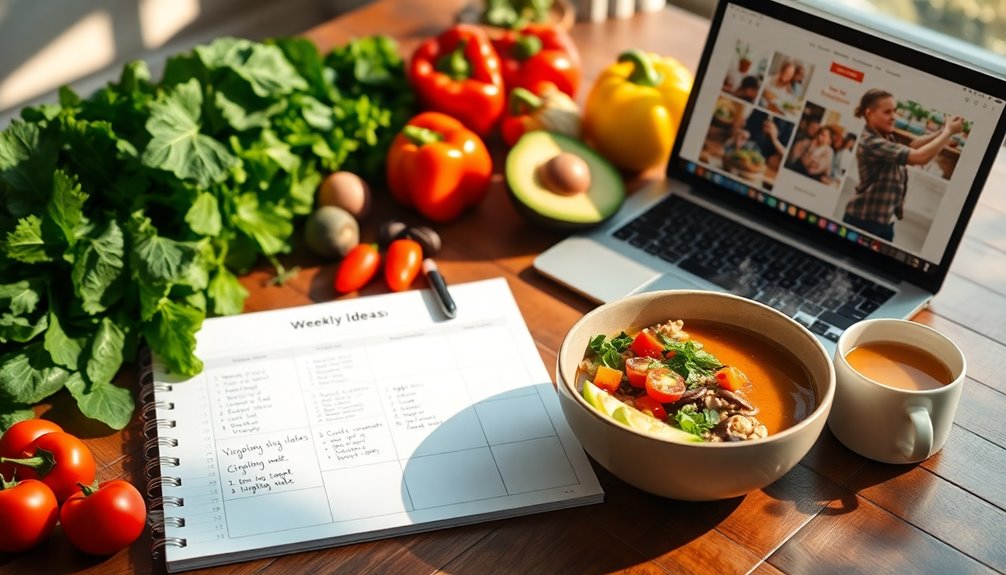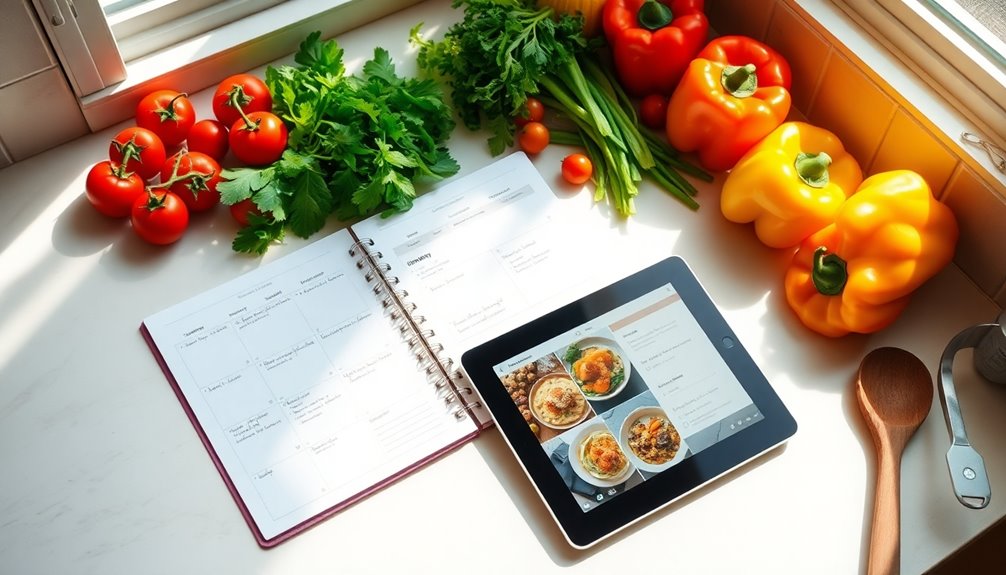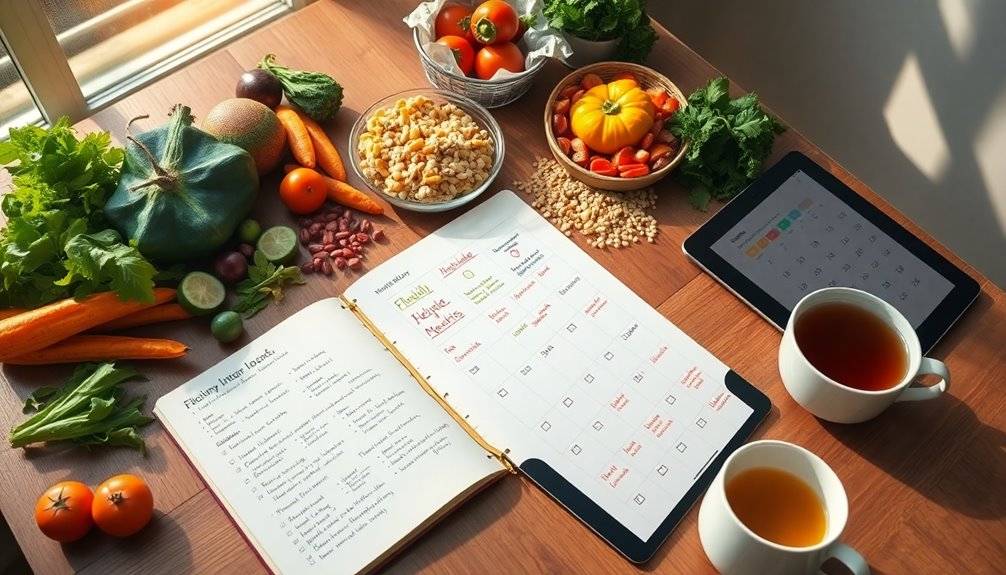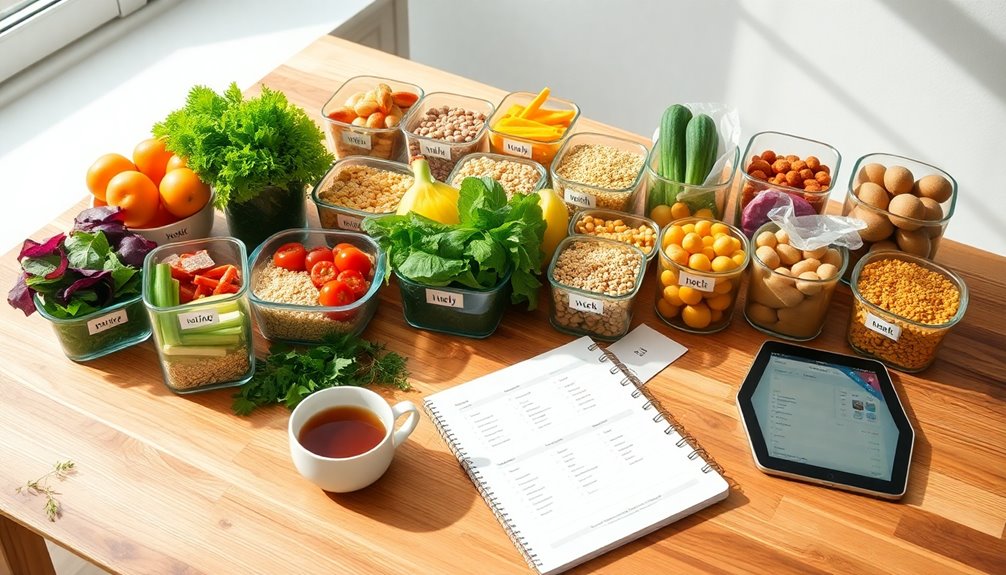To build a weekly meal plan that fits your lifestyle, start by evaluating your routine and identifying your peak meal prep times. Set realistic goals that align with your cooking skills and dietary preferences. Choose straightforward recipes like stir-fries or one-pot meals to save time and reduce stress. Create a grocery list organized by store layout to streamline shopping and avoid impulse buys. Stay flexible by swapping recipes or incorporating leftovers to adapt to your week. With thoughtful planning, you'll not only save time but also enjoy healthier meals—there's more to explore to refine your meal prep skills!
Key Takeaways
- Assess your weekly schedule to identify peak meal prep times and allocate dedicated time for cooking.
- Choose simple recipes that align with your cooking skills and dietary preferences for a stress-free experience.
- Create a grocery list based on selected recipes, organizing it by store layout for efficient shopping.
- Incorporate batch cooking and leftovers into your plan to save time and reduce food waste during busy days.
- Stay adaptable by swapping recipes and trying new dishes to keep your meal plan enjoyable and varied.
Assess Your Current Routine

Before delving into meal planning, it's essential to evaluate your current routine. Start by closely examining how you allocate your time each week. Identify when you have the most available time for meal prep and cooking. This step not only aids in time management but also establishes realistic expectations for your meal planning. If you're managing a hectic schedule, you might want to contemplate simpler recipes that require less cooking time or batch cooking on weekends.
Next, gauge your cooking skills. Are you comfortable experimenting with new recipes, or do you prefer sticking to familiar ones? Being truthful about your abilities can prevent future frustrations. If you're new to cooking, think about commencing with straightforward meals that use fewer ingredients, gradually broadening your culinary range as your skills advance.
Budgeting is another vital aspect to take into account. Evaluate how much you're willing to allocate for groceries each week. Adhering to a budget helps avoid overspending and motivates you to make wiser ingredient choices. Explore local stores for ingredient availability; some items may be more convenient and cost-effective than others depending on the season or location.
Lastly, make a note of the ingredients you already possess at home. This not only minimizes waste but also ignites creativity in your meal planning. By evaluating your current routine, you'll establish a strong foundation for a meal plan that seamlessly aligns with your lifestyle. Additionally, incorporating plant-based recipes into your meal prep can enhance not only your cooking skills but also your overall health and well-being.
Identify Your Dietary Preferences

When planning your meals, identifying your dietary preferences is pivotal for creating a plan that you'll enjoy and stick to. Understanding your unique tastes, allergies, and restrictions can help you choose meals that fit your lifestyle while also making dining a joyful experience. Start by considering your flavor preferences—do you lean towards spicy, savory, or sweet? This can guide your meal choices and make your planning more satisfying.
Next, be sure to account for any allergies or dietary restrictions. Whether you're gluten-free, lactose intolerant, or following a vegetarian or vegan diet, knowing these limitations is essential for your health and well-being. Here's a simple table to help you categorize your dietary preferences:
| Category | Examples | Notes |
|---|---|---|
| Flavor Preferences | Spicy, Sweet, Savory | Favorite cuisines (e.g., Thai) |
| Allergies | Nuts, Shellfish | Severity of allergy |
| Restrictions | Vegetarian, Gluten-free | Specific foods to avoid |
| Healthy Choices | Whole grains, Fresh veggies | Foods you enjoy |
| Treats | Desserts, Snacks | Indulgences you love |
Incorporating a custom keto diet plan can also enhance your meal preparation by providing structured options that align with your dietary preferences.
Set Realistic Goals

Setting realistic goals is vital for successfully implementing your weekly meal plan. When you set achievable objectives, you're more likely to stick with them and feel a sense of accomplishment. Start by evaluating how much time you can realistically dedicate to meal prep each week. This isn't just about cooking; consider time management for grocery shopping and cleaning up afterward. If you know you only have a couple of hours, aim for a plan that fits within that timeframe.
Next, think about your dietary preferences and nutritional needs. Goal setting isn't just about creating a menu; it's about aligning your meals with what you enjoy and what fuels your body.
For instance, if you love cooking but find yourself exhausted by midweek, aim for a plan that incorporates leftovers or batch cooking. This way, you won't feel overwhelmed and can still enjoy home-cooked meals.
It's also important to factor in your lifestyle. If you're busy with work or family commitments, you might want to set a goal to include quick, nutritious meals that require minimal prep time. By clearly defining your goals, you give yourself a roadmap that fits your reality.
Choose Simple Recipes

Choosing simple recipes is a key strategy for maintaining an effective weekly meal plan. When you opt for straightforward dishes, you reduce stress and save time in the kitchen. This approach allows you to focus on what truly matters—enjoying meals with family and friends.
Quick meals, like stir-fries or one-pot pastas, can be prepared in 30 minutes or less, making them perfect for busy weeknights.
Moreover, simple recipes often rely on fewer ingredients, which can help you stick to budget options. Think about meals that incorporate pantry staples like rice, beans, and seasonal vegetables. Not only do these ingredients promote healthier eating habits, but they also encourage creativity. You might find a new family favorite by mixing and matching flavors.
When choosing recipes, consider those that can be easily customized. For instance, a basic taco night can be transformed based on what you have on hand—cooking up chicken, beef, or even veggies. You'll foster a sense of belonging by involving your loved ones in the cooking process, allowing everyone to contribute their favorite toppings. Additionally, incorporating delicious recipes and meal plans into your weekly rotation can enhance your overall health and well-being.
Create a Shopping List

Creating a shopping list is essential for efficiently executing your weekly meal plan. It not only streamlines your meal prep but also helps with budgeting, ensuring you only buy what you need. Start by reviewing your chosen recipes and noting the ingredients required. This will prevent those last-minute trips to the store, keeping your week organized and stress-free.
Here's a simple table to help you visualize your shopping list:
| Category | Ingredients | Quantity |
|---|---|---|
| Proteins | Chicken breast | 2 lbs |
| Vegetables | Broccoli | 1 bunch |
| Grains | Quinoa | 1 lb |
If you're tight on time, consider utilizing online grocery shopping or meal delivery services. These options can save you time and often allow you to stick to your budget. When you shop online, you can easily adjust your list, compare prices, and avoid impulse buys. Plus, meal delivery services can provide pre-portioned ingredients, making meal prep even more manageable.
To make the most out of your shopping list, consider organizing it by store layout. Grouping items by category not only saves time but also enhances your shopping experience. Remember, a well-planned shopping list is your trusty companion on the journey to healthy eating, enabling you to connect with your meals and community in a more meaningful way. Incorporating whole-food protein into your meals can help meet your nutritional needs more effectively.
Stay Flexible and Adjust

Flexibility is key when it comes to sticking to your weekly meal plan. Life is unpredictable, and while it's great to have a plan, you also need to be ready to adjust it as needed. Maybe an unexpected event pops up, or you find yourself craving a meal that wasn't on your list. That's perfectly okay! Adapting your meal prep to fit your current situation can help you stay on track without feeling restricted.
Start by keeping a few quick meals in your arsenal. These are go-to recipes that require minimal effort and time, allowing you to whip something up without feeling overwhelmed. Think of dishes like stir-fries, salads, or pasta that can easily incorporate whatever ingredients you have on hand.
This way, if your original plan needs to change, you won't resort to takeout or unhealthy options. Additionally, having a strong foundation of proper glute activation can enhance your overall fitness and energy levels, making it easier to tackle meal prep.
When you notice a recipe isn't working for you that week, switch it out for something more appealing or convenient. If you find you're consistently running out of time, consider prepping larger batches of meals on your day off.
This will give you a stash of ready-to-go meals that can ease those busy weeknights.
Frequently Asked Questions
How Do I Involve My Family in Meal Planning?
Involving your family in meal planning can make the process more enjoyable and inclusive. Start by discussing family preferences and asking for input on favorite meals. Get the kids involved by letting them help with meal prep and choosing recipes.
When it's time for grocery shopping, bring them along to pick out fresh ingredients. This not only teaches them about healthy eating but also fosters a sense of belonging and teamwork within your family.
What Tools Can Help Streamline Meal Prepping?
To streamline meal prepping, you can use meal planner apps that help you organize your recipes and shopping lists efficiently. These tools allow you to input your favorite dishes, making it easy to plan meals for the week ahead.
Additionally, recipe organization features let you sort by dietary preferences or occasions, ensuring you've got options for everyone.
With these resources, you'll save time and feel more connected to your meal prep routine.
How Can I Save Money While Meal Planning?
Think of meal planning as a treasure hunt for savings! To save money, focus on budget-friendly recipes that utilize seasonal ingredients. Try grocery hacks like buying in bulk or shopping sales to lower costs. Planning meals around what's on sale can also help stretch your dollars further. By combining these strategies, you can create a delicious, affordable menu while feeling like part of a community that values smart spending.
What Should I Do With Leftovers?
When you've got leftovers, consider a leftover transformation. Get creative! Turn last night's roasted veggies into a delicious frittata or blend them into a soup.
If you can't use them soon, freezing extras is a smart move. Just portion them out in airtight containers, and label them with dates. This way, you'll minimize waste and have ready-made meals when you're busy, making your life easier while saving money.
Enjoy your delicious creations!
How Do I Handle Unexpected Schedule Changes?
Handling last minute changes can be tricky, but you can still stay healthy. When unexpected events arise, adjust your meal plans by keeping versatile ingredients on hand.
Use leftovers creatively to avoid waste; for instance, toss them into a quick stir-fry or salad. Having a few easy recipes ready helps you adapt without stress.
Conclusion
In crafting your weekly meal plan, think of it as planting a garden. You start with seeds—your goals and preferences—and nurture them with simple recipes and a well-prepared shopping list. As you cultivate this routine, flexibility allows your garden to thrive, adjusting to the seasons of your life. By taking these steps, you're not just feeding your body; you're creating a sustainable lifestyle that blooms with health and satisfaction. Embrace the journey, and watch your efforts flourish.



